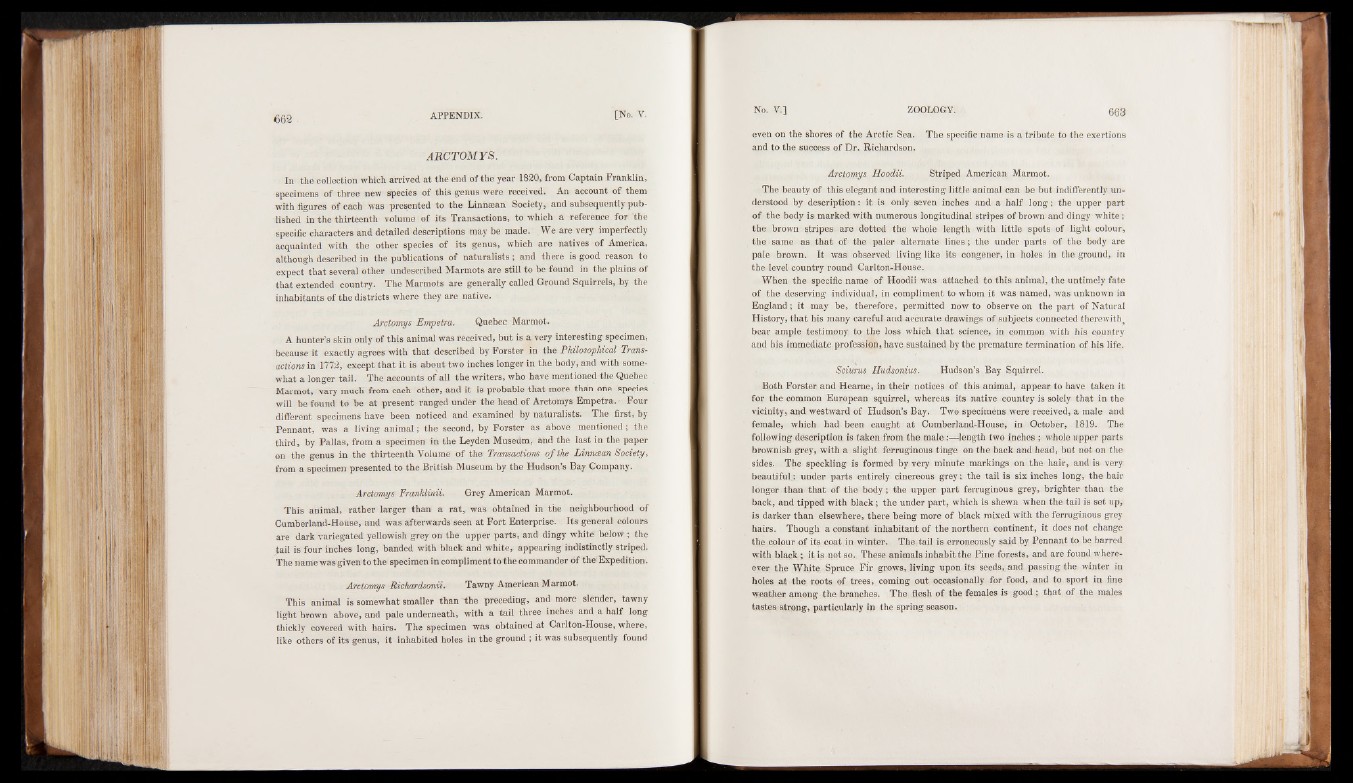
A R C T O M Y S .
In the collection which arrived at the end of the year 1820, from Captain Franklin,
specimens of three new species of this genus were received. An account of them
with figures of each was presented to the Linnsean Society, and subsequently published
in the thirteenth volume of its Transactions, to which a reference for the
specific characters and detailed descriptions may be made. We are very imperfectly
acquainted with the other species of its genus, which are natives of America,
although described in the publications of naturalists ; and there is good reason to
expect that several other undescribed Marmots are still to be found in the plains of
that extended country. The Marmots are generally called Ground Squirrels, by the
inhabitants of the districts where they are native.
Arctomys Empetra. Quebec Marmot.
A hunter’s skin only of this animal was received, but is a very interesting specimen,
because it exactly agrees with that described by Forster in the Philosophical Transactions
in 1772, except that it is about two inches longer in the body, and with somewhat
a longer tail. The accounts of all the writers, who have mentioned the Quebec
Marmot, vary much from each other, and it is probable that more than one species
will be found to be at present ranged under the head of Arctomys Empetra.' Four
different specimens have been noticed and examined by naturalists. The first, by
Pennant, was a living animal; the second, by Forster as above mentioned; the
third, by Pallas, from a specimen in the Leyden Musedm, and the last in the paper
on the genus in the thirteenth Volume of the Transactions of the Linruzan Society,
from a specimen presented to the British Museum by the Hudson’s Bay Company.
Arctomys Franklinii. Grey American Marmot.
This animal, rather larger than a rat, was obtained in the neighbourhood of
Cumberland-House, and was afterwards seen at Fort Enterprise. Its general colours
are dark variegated yellowish grey on the upper parts, and dingy white below ; the
tail is four inches long, banded with black and white, appearing indistinctly striped.
The name was given to the specimen in compliment to the commander of the Expedition.
Arctomys Richardsonii. Tawny American Marmot.
This animal is somewhat smaller than "the preceding, and more slender, tawny
light brown above, and pale underneath, with a tail three inches and a half long
thickly covered with hairs. The specimen was obtained at Carlton-House, where,
like others of its genus, it inhabited holes in the ground ; it was subsequently found
even on the shores of the Arctic Sea. The specific name is a tribute to the exertions
and to the success of Dr. Richardson.
Arctomys Hoodii. Striped American Marmot.
The beauty of this elegant and interesting little animal can be but indifferently understood
by description: it is only seven inches and a half long; the upper part
of the body is marked with numerous longitudinal stripes of brown and dingy white;
the brown stripes are dotted the whole length with little spots of light colour*
the same as that of the paler alternate lines; the under parts of the body are
pale brown. It was observed living like its congener, in holes in the ground, in
the level country round Carlton-House.
When the specific name of Hoodii was attached to this animal, the untimely fate
of the deserving individual, in compliment to whom it was named, was unknown in
England; it may be, therefore, permitted now to observe on the part of Natural
History, that his many careful and accurate drawings of subjects connected therewith
bear ample testimpny to the loss which that science, in common with his country
and his immediate profession, have sustained by the premature termination of his life.
Sciurus Hudsonius. Hudson’s Bay Squirrel.
Both Forster and Heame, in their notices of this animal, appear to have taken it
for the common European squirrel, whereas its native country is solely that in the
vicinity, and westward of Hudson’s Bay. Two specimens were received, a male and
female, which had been caught at Cumberland-House, in October, 1819. The
following description is taken from the male:—length two inches ; whole upper parts
brownish grey, with a slight ferruginous tinge on the back and head, but not on the
sides. The speckling is formed by very minute markings on the hair, and is very
beautiful: under parts entirely cinereous grey; the tail is six inches long, the hair
longer than that of the body; the upper part ferruginous grey, brighter than the
back, and tipped with black; the under part, which is shewn when the tail is set up,
is darker than elsewhere, there being more of black mixed with the ferruginous grey
hairs. Though a constant inhabitant of the northern continent, it does not change
the colour of its coat in winter. The tail is erroneously said by Pennant to be barred
with black; it is not so. These animals inhabit the Pine forests, and are found where-
ever the White Spruce Fir grows, living upon its seeds, and passing the winter in
holes at the roots of trees, coming out occasionally for food, and to sport in fine
weather among the branches. The flesh of the females is good; that of the males
tastes strong, particularly in the spring season.